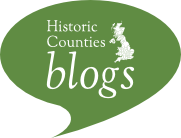
Radnorshire is blessed with several symbolic traditions, resulting in the availability of four designs arguably eligible for registration as a traditional flag. On the face of it, it would seem that a variation of the banner of the arms
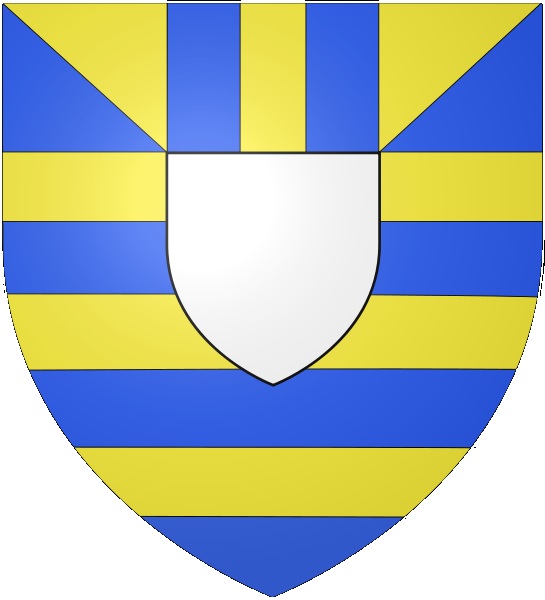
of the Mortimer family might be the obvious choice for deployment as the county’s flag, as depicted above. The arms have been used in the locality for many centuries, this is a 14th century version

By the eighteenth century the arms had become pointedly linked with the territory of the county, used for example to designate it specifically on maps 

The strong association of the Mortimer arms with the county of Radnorshire was later demonstrated by their use by the local police force
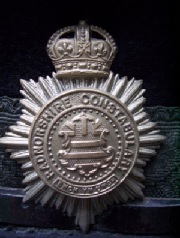
and again by the county council’s informal use of the emblem (minus the white shield at the centre) as its own arms
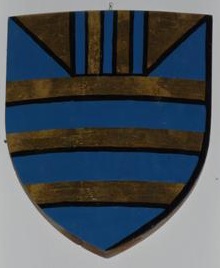 as attested to by two authoritative references;
as attested to by two authoritative references;
The Book of Public Arms by A.C. Fox-Davies, 1894. Plate 9
Has no Armorial bearings, but the following are quoted in Burke’s ‘General Armory’ – “Barry of six or and az on a chief of the last two palets betw as many gyrons of the first” This Coat is probably taken from that of Mortimer, which as blazoned in Woodward and Burnetts ‘Treasure on Heraldry,’ is as follows- “Parry of six or and azure on a chief of the first two pallets between two gyrons of the second, over all au inescutcheon argent”.
Civic Heraldry by C.W. Scott-Giles, 1933. Page 88
Upon the seal of the County Council appears a shield: Barry of six pieces of gold and blue on a blue chief two gold pallets between two gold gyrons. This is clearly based on the arms of the Mortimers, Earls of March (the Welsh march), who bore these arms with the addition of a silver escutcheon in the middle of the shield.
The Mortimers possibly devised their arms as an heraldic representation of the Dead Sea, from which the family ‘de Mortuo Mari’ were supposed to have derived their name; the silver escutcheon may be intended to stand for the waters, and the gold and blue pieces about the sands and sky.
In 1954 the council was formally awarded a new coat of arms

which again included a reference to the Mortimers and their arms, with a yellow and blue border around the edge of the shield. Further recognition of the close linkage of the Mortimer emblem with Radnorshire is evident in its appearance on the ceiling of the library in Bangor University
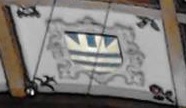
where it appears amidst a number of emblems representing the Welsh counties. Thus the above flag, based on this interpretation of the original Mortimer arms, without a central white shield or “inescutcheon”, is a legitimate proposal for registration as the county flag of Radnorshire. However, in the modern era the Mortimer family has come to be seen by some local people as representative of an occupying foreign force on account of the family’s origin as a Norman dynasty which arrived in Wales in the centuries following the Battle of Hastings, notwithstanding the fact that the family ultimately intermarried with native born nobility and after several hundred years had become Welsh itself by any reasonable definition. In contrast attention has turned instead to the native born Elystan Glodrydd and his son Cadwgan. Elystan Glodrydd is mentioned in historical annals as being King of Rhwng Gwy a Hafren, which in English is ‘Between Wye and Severn’. This family was a principal opponent to the incoming Mortimers and many modern inhabitants of Radnorshire choose to celebrate this role by use and display of the arms associated with father and son. The arms attributed to Elystan Glodrydd were a gold lion on a red shield
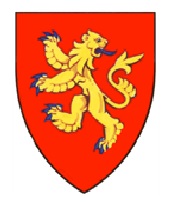
whilst his son received a most distinctive white shield bearing three boars heads
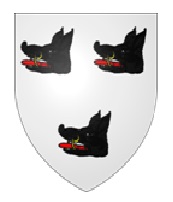
The two sets of arms, quartered
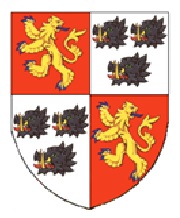
became the arms of the Cadogan and other families and this armorial banner has been used by them from an early date. It was memorably seen flying in Radnorshire in 2010, when the descendants of Elystan Glodrydd organised a historic gathering to commemorate the 1000th anniversary of the supposed year of his death in battle,
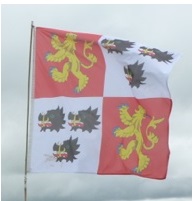
along with an armorial banner of the Elystan Arms themselves 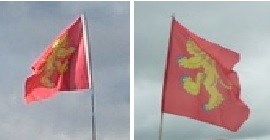 .
.
Thus there are three alternative designs which have some validity to claim right for use as the county flag, all armorial banners, derived from the above arms;
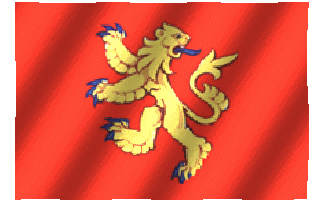
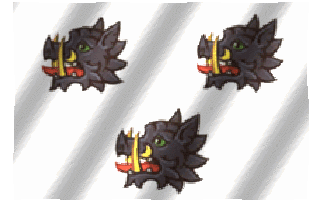
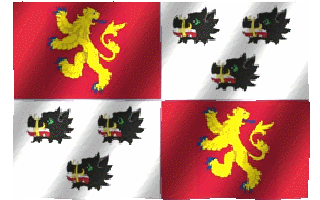
The quartered flag is avowedly heraldic in composition and probably not suitable for registration on style grounds – being too complicated to draw and insufficiently distinct or definitive in appearance. The Elystan banner has a strong claim for registration – its provenance and usage on the later council arms, make it comparable to the proposed flag of Ceredigion (Cardiganshire) but it should be noted that there are potentially at least three rampant lion flags in the offing – gold on black in Ceredigion, black on white in Denbighshire and gold on red in Radnorshire – plus theoretically another in Montgomeryshire as it has been suggested that the red lion rampant on gold, banner of Powys Wenwynwyn (Powys Cyfeiliog) is a likelier traditional flag for that county. A veritable pride of lions! If these were all registered the crucial element of distinctiveness that makes flags effective, would be sorely diminished – few would be able to tell one Welsh county lion flag from another. Additionally rampant lions are a theme that is universally met in heraldry and heraldically derived flags – there are a myriad lions in corporate, civic and personal arms across the globe. On this basis seeking something that can represent a county which is unique or rare is certainly the preferable course. The three boars heads therefore might make a better flag, certainly a more distinctive one although generally flags that are all white around the edges tend to be avoided for fear of being lost against a cloudy sky. And to use one of these designs would be to ignore entirely, the Mortimer contribution to local history – given the established association between the Mortimer emblem and the county would this really be fair? A number of designs seeking a compromise of these conflicting themes and stances have arisen in the wake of discussions about the best flag for Radnorshire, which can be seen on the Radnorshire page in the “novel designs” proposals section located here
http://flags.abcounties.com/2014/01/28/radnorshire-3/
Thanks to Brady Ells for his extensive research used in this account.
